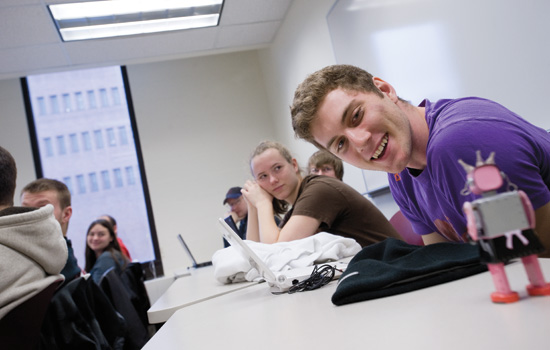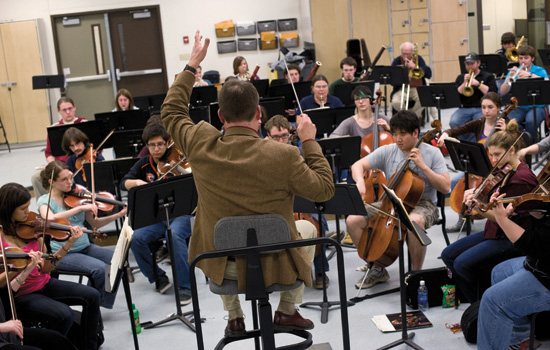Making liberal arts matter
That’s how you teach humanities at RIT
A. Sue Weisler
Michael Ruhling, associate professor of fine arts/music and conductor of the RIT Orchestra, leads a rehearsal for the spring concert. Students from a variety of majors participate in the orchestra and take it for course credit.
Samir Nazir ’10 was working as a mechanical engineer in the oil industry in Texas when he decided he wanted to get a master’s degree in interdisciplinary studies so he could have an impact on how energy is consumed by transportation.
He Googled transportation, public policy and graduate degrees and came across the master’s degree in science, technology and policy offered through RIT’s College of Liberal Arts.
“It was interesting to me that an institute of technology would have such a strong niche program in public policy and government,” says Nazir, who has a bachelor’s degree in mechanical engineering from the University of Texas. “But the degree program at RIT really fit my needs both because of the actual coursework and research opportunities it offered.”
Nazir’s experience shows how the College of Liberal Arts has developed into a world-class center for the study of humanities, social sciences and technology. Through its cutting-edge research programs and unique degree offerings, the college now attracts its own brand of students and has a central role on campus.
In addition, the college ensures students in all majors don’t leave RIT without experiencing the social sciences and humanities. The goal is to make liberal arts matter for engineers and scientists and in the process create more engaged thinkers.
“Some might question why a technical university would focus on developing strong programs in subjects such as public policy, philosophy, fine arts, communication and modern languages and culture,” says James Winebrake, dean of the college. “But it has been proven that these disciplines assist scientists and engineers in becoming better managers, writers and critical thinkers.”
Growing a college
Arts and social sciences have been taught on campus since the early 1900s, but the College of Liberal Arts did not become its own entity until the 1970s.
A group of faculty members began to push for a greater emphasis on liberal arts, leading to the development of the college’s first degree programs. This included a Bachelor of Science in criminal justice in 1973 and a master’s degree in school psychology in 1976.
Over the next two decades, the college continued to expand its degree and research offerings, which now include an undergraduate degree in professional and technical communication; a master’s degree in applied, experimental and engineering psychology; and technically focused bachelor’s degrees in philosophy, criminal justice and political science.
Today, the college consists of 15 departments with 635 undergraduates, 107 graduate students and 150 faculty members. It offers 12 undergraduate programs and five graduate degrees. The model of combining a technical education with the social sciences and humanities extends beyond RIT.
Massachusetts Institute of Technology and Georgia Tech have strong liberal arts colleges that offer similar programs, says Winebrake, who became dean earlier this year.
Winebrake hopes to strengthen and potentially expand degree offerings in the college. He also wants to increase research, internships and co-op opportunities for students both in liberal arts disciplines and in multi-disciplinary programs.
Nazir, who graduated in 2010 with a degree in science, technology and public policy, was able to gain real-world policy analysis experience through an internship with the U.S. Department of State.
He is serving as a Fulbright fellow and energy analyst with the National University of Singapore to assess the potential impact of electric vehicles on Singapore’s transportation system. (While at RIT, Nazir took Chinese courses also offered through the College of Liberal Arts, hoping he would land a job in Singapore.)
“Many organizations around the world are looking for problem solvers that have technical and social science competencies,” he says. “I feel the social science training I received at RIT makes me uniquely qualified to excel in a world of challenges that are technical, market-based, and may require policy interventions.”
Popular courses
At RIT, even computer scientists and mechanical engineers have to experience social sciences and humanities. In fact, on average, the college teaches about 25 percent of all student credit hours on campus and all undergraduates are required to take at least one liberal arts course.
In Deborah Blizzard’s cyborg theory class, students from a variety of majors discuss the meaning of the word cyborg (a machine-enhanced human), how cyborg theory has transformed technology, as well as why robots are cool.
In a typical class, students get to interact with multiple robots, from an automated light-emitting dragon to Rosie the robot maid from the animated television show The Jetsons. Blizzard discusses how robots affect everything from economics to politics.
“A class like cyborg theory allows students to develop a deeper understanding of the often negative impacts of technological development,” says Blizzard, chair of the Department of Science, Technology and Society/Public Policy.
Cyborg theory is one of the most popular courses in the college with a long waiting list each spring. Other popular courses include slavery and race in America, deaf cultural studies and the RIT Orchestra, which participating students can take for credit.
“My education at RIT was grounded in science and technology but I also learned the violin-bowing nuances of a Beethoven symphony,” says Paul Melnychuck, who was the orchestra’s first concertmaster and graduated with a bachelor’s degree in chemistry in 1983 and a master’s degree in imaging science in 1984.
“I would say the music program had a profound effect on me that not only helped me pursue a dual path in the arts and technology, but enabled cross-pollination of ideas that led to inventions.”
Melnychuck has a 30-year career in digital imaging, audio and music technology that included 12 years as a senior research scientist at Kodak Research Laboratories.
He recently released his debut album, Reaching Out Looking In, and is advising start-up companies in digital publishing and social media.
Winebrake says this shows the importance of liberal arts in all majors.
“The social sciences, arts and humanities are not just subjects students learn in a class,” he says. “They are tools that make life more interesting.”
Did you know
RIT’s College of Liberal Arts
- Delivered more than 150,000 credit hours of teaching annually or 25 percent of all credit hours provided. That is the most of any college at RIT.
- Offers 30 minors, including deaf cultural studies and music and technology, and 40 concentrations, such as women and gender studies and Native American science and technology.
- In May, graduated its first class from its journalism program, which has a focus on new- media communication.
- Teaches courses in nine languages, including Russian, Japanese and American Sign Language.
- Received almost $1.8 million in sponsored research funding in 2010.
- Hosts five endowed chairs in economics, humanities, communication, applied ethics and international studies.
- Produced 49 books and more than 190 journal articles, book chapters and poems in 2009 and 2010.
- Houses the RIT Orchestra, a student performing arts group. The orchestra presented the world premiere of noted composer Frederick Lesemann’s Concerto for Violin and Orchestra at its 2011 Winter Concert.
- Includes the Center for Public Safety Initiatives, a crime research partnership between the Department of Criminal Justice, the Rochester Police Department, the Monroe County District Attorney’s Office and the U.S. Department of Justice.
What liberal arts alumni are doing
Educator: Debra Heath-Thornton ’81 (criminal justice) of Drexel Hill, Pa., is the dean of the Campolo College of Graduate and Professional Studies at Eastern University.
“RIT’s program has always sought to combine the technical aspects of criminal justice with the necessary social and cultural components needed to create well-rounded graduates.”
EPA analyst: Kate Kimmel-Robinson ’07 (science technology and policy) of Glenmoore, Pa., is a program analyst at the Environmental Protection Agency’s Office of the Inspector General.
“The science, technology and policy program taught me the importance of factual, unbiased analysis. It has been refreshing to use so much of what I learned in the real world.”
Company president: Mike Ramsager ’89 (economics) of Pittsford, N.Y., is president of Internet applications for SchoolWorld, a division of Edline, one of the nation’s largest online education providers. “The economics program at RIT helped me understand the business aspects of the world and planted seeds that gave me the determination and ambition to start my own company. All you need is an idea or a dream.”
Editor: Sophie Schillaci ’10 (advertising and public relations) of Los Angeles, Calif., is a contributing editor for Zap2it.com, an entertainment news site produced by the Tribune Co. “Being at RIT forced me to learn basic skills involving Web design, coding and Photoshop. I use these skills each day.”
Brain researcher: Jonathan Winkle ’09 (psychology) of Cambridge, Mass., is a research assistant with the McGovern Institute for Brain Research at MIT. “Allow me to make a suggestion to my RIT comrades: Don’t settle for anything. Whether it is your major, your job, or your girlfriend. Happiness comes through discovering and pursuing your passions.”
 Edward McKenna Jr., a fifth-year computer engineering technology student, studies Rosie the robot maid from The Jetsons during his cyborg theory class. The popular course provides students with an opportunity to learn about the societal impact of technology. A. Sue Weisler
Edward McKenna Jr., a fifth-year computer engineering technology student, studies Rosie the robot maid from The Jetsons during his cyborg theory class. The popular course provides students with an opportunity to learn about the societal impact of technology. A. Sue Weisler














